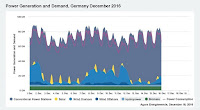The prominent German economist Heiner Flassbeck has challenged fundamental assumptions of the Energiewende at his blog site makroskop.eu. According to Flassbeck, the former Director of Macroeconomics and Development at the UNCTAD in Geneva and a former State Secretary of Finance, a recent period of extremely low solar and wind power generation shows that Germany will never be able to rely on renewable energy, regardless of how much new capacity will be built.
Stable high-pressure winter weather has resulted in a confrontation. An Energiewende that relies mainly on wind and solar energy will not work in the long run. One cannot forgo nuclear power, eliminate fossil fuels, and tell people that electricity supplies will remain secure all the same.
We have attempted unsuccessfully to find Energiewende advocates willing to explain that inconsistency. Their silence is not easy to fathom. But maybe the events themselves have made the outcome inevitable.
With nuclear power no longer available, a capacity of at least 50 gigawatts is required by other means, despite an enormously expanded network of wind turbines and solar systems
This winter could go down in history as the event that proved the German energy transition to be unsubstantiated and incapable of becoming a success story. Electricity from wind and solar generation has been catastrophically low for several weeks. December brought new declines. A persistent winter high-pressure system with dense fog throughout Central Europe has been sufficient to unmask the fairy tale of a successful energy transition, even for me as a lay person.
This is a setback, because many people had placed high hopes in the Energiewende. I likewise never expected to see large-scale solar arrays and wind turbines, including those offshore, motionless for days on end. The data compiled by Agora Energiewende on the individual types of electricity generation have recorded the appalling results for sun and wind at the beginning of December and from the 12th to 14th:
Of power demand totaling 69.0 gigawatts (GW) at 3 pm on the 12th, for instance, just 0.7 GW was provided by solar energy, 1.0 by onshore wind power and 0.4 offshore. At noontime on the 14th of December, 70 GW were consumed, with 4 GW solar, 1 GW onshore and somewhat over 0.3 offshore wind. The Agora graphs make apparent that such wide-ranging doldrums may persist for several days.
You do not need to be a technician, an energy expert, or a scientist to perceive the underlying futility of this basic situation. You simply need common sense, shelving expectations and prognoses for a moment, while extrapolating the current result to future developments. Let us suppose that today’s wind and solar potential could be tripled by 2030, allowing almost all of the required energy to be obtained from these two sources under normal weather conditions. This is an extremely optimistic scenario and certainly not to be expected, because current policy is slowing down the expansion of renewable energy sources rather than accelerating it.
Read more at The End of the Energiewende?

No comments:
Post a Comment